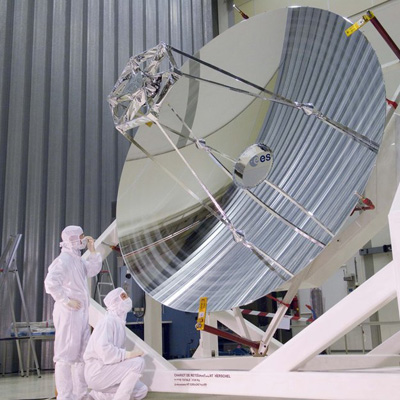In this view of the Andromeda galaxy from Herschel, cool lanes of forming stars are revealed in clear detail. Photo via ESA/PACS & SPIRE Consortium
The European Space Agency (ESA) has confirmed that Herschel, the largest infrared space telescope ever launched, has exhausted its supply of liquid helium coolant and is ending more than three years of observations of the cold universe.
Launched in 2009 from Europe’s Spaceport in Kourou, French Guiana, Herschel has been carrying the largest space telescope ever launched to date. Since then, it has been collecting long-wavelength infrared radiation from some of the coolest and most distant objects in the universe.
The telescope is named after the German-British astronomer William Herschel. In 1800, he discovered infrared radiation while studying the sun.
Herschel’s mission began with more than 2,300 litres of liquid helium, which has been slowly evaporating since the final top-up the day before Herschel’s launch on 14 May 2009.
The evaporation of the liquid helium was necessary to cool the observatory’s instruments to close to absolute zero so as to allow Herschel to make highly sensitive scientific observations of the cold universe.
The ESA said confirmation that Herschel’s helium is finally exhausted came today at the beginning of the spacecraft’s daily communication session with its ground station in western Australia. A clear rise in temperatures was measured in all of Herschel’s instruments.
“Herschel has exceeded all expectations, providing us with an incredible treasure trove of data that will keep astronomers busy for many years to come,” said Prof Alvaro Giménez, ESA’s director of science and robotic exploration.
During its foray in space, Herschel has made more than 35,000 scientific observations and has amassed more than 25,000 hours of science data from about 600 observing programmes.
Data from its mission is being archived at the ESA’s European Space Astronomy Centre, near Madrid in Spain.

Herschel’s 3.5m telescope mirror. Photo via ESA
Herschel has been carrying the largest telescope mirror ever flown in space used sensitive direct detectors for light in the far-infrared to millimetre range.
The telescope has taken images of intricate networks of dust and gas filaments within the Milky Way to give insight into how stars have formed.
The ESA said that Herschel far-infrared observations have also given astronomers a new insight into how turbulence stirs up gas in the interstellar medium.
“Herschel has offered us a new view of the hitherto hidden universe, pointing us to previously unseen processes of star birth and galaxy formation, and allowing us to trace water through the universe from molecular clouds to newborn stars and their planet-forming discs and belts of comets,” said Göran Pilbratt, ESA’s Herschel project scientist.
While Herschel’s universe-observing may be over, Pilbratt said this does not signal the end of the mission. “We will now concentrate on making our data accessible in the form of the best possible maps, spectra and various catalogues to support the work of present and future astronomers,” he said.
As for Herschel, the ESA said that the spacecraft will be propelled into its long-term parking orbit around the sun in May.